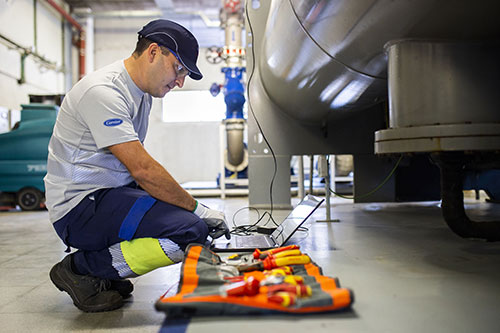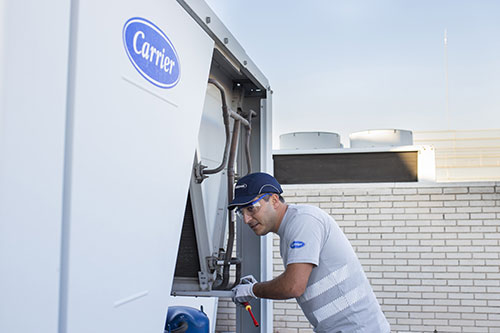Energy Audits Are a Catalyst for Decarbonisation
LEATHERHEAD, UK -
In an era marked by rising energy costs and stringent environmental regulations across the UK and rest of Europe, optimising energy use in commercial buildings is not just financially imperative, it is critical in the race to decarbonisation, says Ralph Davies, Head of Sales at Carrier Service.
Buildings are currently responsible for 39% of global energy related carbon emissions; 28% comes from operational emissions produced by the energy needed to heat, cool and power them.
The International Energy Agency’s (IEA) Net Zero Emissions 2050 roadmap calls for a doubling of efforts to improve building efficiency as part of a broader strategy to achieve global net-zero emissions by 2050.
The roadmap emphasises the need for the deployment of clean energy technologies and energy-efficient building retrofits within this decade to stay on course. An energy audit can be the tool building owners can use to make positive changes to decarbonise their buildings.
Understanding energy audits and their necessity
In terms of Heating, Ventilation, and Air Conditioning, energy audits are a method for identifying inefficiencies in a building’s HVAC system. These audits not only help to pinpoint areas where energy consumption can be optimised but also offer a pathway to align with sustainability targets, thereby contributing to the broader goals of reducing greenhouse gas emissions and enhancing energy independence.
Large commercial properties in the UK are often subject to certain legislation around energy. So regardless of the desires to lower emissions, in order to comply with legislation like the Energy Savings Opportunity Scheme (ESOS) and the Streamlined Energy and Carbon Reporting (SECR) it is necessary for building owners to have efficient heating and cooling equipment.
A structured approach to audits
Conducting HVAC system analysis can seem like a complex task, but with the right approach and tools it doesn’t need to be. Knowing how to analyse your commercial HVAC system is key to determine if you’re getting peak performance from your investment, as well as diagnose primary sources of energy loss. At Carrier, we follow five key stages when completing an energy audit.
1, Gathering data
The first step in conducting an energy audit is to gather comprehensive data on the current energy consumption patterns of the system. This involves collecting historical energy usage and costs, monitoring system outputs, and using sensors or meters to record real-time energy usage. This data provides a clear picture of where and how energy is being used within the building.
2, Establish performance baseline
With the collected data, auditors establish a performance baseline that serves as a reference point for evaluating the efficiency of the HVAC system. This baseline is critical for understanding the typical energy demands and identifying periods of unusually high or low usage, which might indicate inefficiencies or opportunities for improvement.
3, Setting benchmarks
After establishing the baseline, the next step is to set benchmarks based on industry standards ISO 50002 or BS EN 16247 – both accepted methodologies in the UK. These benchmarks allow auditors to compare the building’s performance against the defined minimum set of requirements and best practices, helping to identify areas where the building underperforms.
4, Conducting gap analysis
Using the benchmarks, auditors conduct a gap analysis to determine the discrepancies between the current performance of the HVAC system and the established levels. This analysis helps to pinpoint specific areas where improvements can be made and identifies the potential savings and benefits of making those improvements.
5, Recommending energy conservation measures
Based on the insights gained from the gap analysis, the final step involves recommending specific energy conservation measures.
Recommendations can include simple fixes and adjustments that enhance system performance without extensive upgrades. These may include recalibrating sensor settings to improve accuracy and responsiveness or sealing leaks and improving insulation.
If substantial work is needed to improve efficiency, more complex solutions will be recommended. These upgrades often include installing more advanced AHUs that incorporate heat recovery technologies or replacing a chiller’s fixed speed drive with a variable speed drive, which allows the unit to adjust its output based on real-time demand.
In some case, more substantial recommendations can be made to replace heating systems altogether. The electrification of heat is a key aspect in achieving net zero, and sustainable technology such as heat pumps will facilitate this.
Each recommendation is accompanied by a detailed analysis of the cost of implementation against expected energy savings and CO2 equivalent reduction potential. This step is critical for prioritising measures that yield the most substantial benefits in terms of energy conservation, sustainability impacts, and return on investment.
Additional benefits to energy audits
As well as lowering emissions, there are additional benefits building owners can expect to see if they implement the recommendations from the audit. These include:
Improved occupant satisfaction
An optimised HVAC system can enhance the indoor environment of a building, significantly enhancing occupant comfort and satisfaction. Improved Indoor Air Quality (IAQ) is particularly important as it directly impacts the health, productivity, and well-being of occupants.
Cultural shift towards sustainability
By highlighting the benefits and feasibility of sustainable practices, energy audits can encourage a culture of energy consciousness within organisations, promoting ongoing commitment to energy conservation.
Regular maintenance and expert guidance
Within the audit’s recommendations, on-going servicing and maintenance can prevent energy waste that may otherwise occur due to neglected equipment. Regular servicing not only ensures systems operate at peak efficiency, building managers have the dedicated support of expert technicians who can overcome any challenges during the equipment’s lifespan.
The strategic role of energy audits in lifecycle asset management
It is crucial to ensure your HVAC system is functioning efficiently and effectively. HVAC system analysis and associated equipment, involves a thorough examination of the system’s mechanical and electrical components to identify any issues or deficiencies that may be impacting its overall performance.
A detailed energy audit is essential for improving the efficiency, sustainability, and cost-effectiveness of HVAC systems. By combining proactive assessments with advanced technological solutions, building owners will not only see a marked improvement in their energy performance but also contribute to environmental preservation and achieve tangible financial benefits. These audits align closely with broader energy efficiency and sustainability goals, ensuring that operations are optimised for both immediate gains and long-term sustainability.
Moreover, energy audits form an integral part of a larger, more holistic strategy that focuses on the entire lifecycle of a building’s heating and cooling systems. This broader perspective of asset management ensures that every phase of its lifecycle, from design and installation through to operation, maintenance, and, eventually, replacement, is managed with an eye toward maximising efficiency and minimising environmental impact. By viewing energy audits as a critical component of this lifecycle approach, organisations can implement a continuous improvement process that not only enhances current performance but also paves the way for future innovations, maximum efficiency, and lower carbon emissions.
To find out more about Carrier’s service and aftermarket solutions, including energy audits, please visit the service page.

Carrier’s BluEdge technician gathering data.

Regular maintenance and expert guidance on offer from Carrier’s BluEdge technicians.